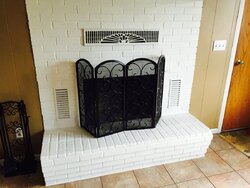Hi all,
I wanted to reach out everyone for your knowledge advice and feedback. I will try to keep this short. About 7 months ago my wife and I purchased our first home. It has a fireplace with an old blower type seystem in it that is non operational and pretty much burned out.
What I would like to do is have my hearth removed and fire box dropped down to the floor ( cement foundation ) so that I can have a free standing wood stove slightly recessed into the new larger space. Current fire place opening is 20" high x 33"wide, if even possible to do the removal of the hearth and expanding the current firebox would make it about 36" x 33". is removing the hearth and enlarging the opening possible? Is it more trouble than it's worth?
I hope the picture helps convey what I am trying to accomplish. Thank you for any direction it will be appreciated.
I wanted to reach out everyone for your knowledge advice and feedback. I will try to keep this short. About 7 months ago my wife and I purchased our first home. It has a fireplace with an old blower type seystem in it that is non operational and pretty much burned out.
What I would like to do is have my hearth removed and fire box dropped down to the floor ( cement foundation ) so that I can have a free standing wood stove slightly recessed into the new larger space. Current fire place opening is 20" high x 33"wide, if even possible to do the removal of the hearth and expanding the current firebox would make it about 36" x 33". is removing the hearth and enlarging the opening possible? Is it more trouble than it's worth?
I hope the picture helps convey what I am trying to accomplish. Thank you for any direction it will be appreciated.


